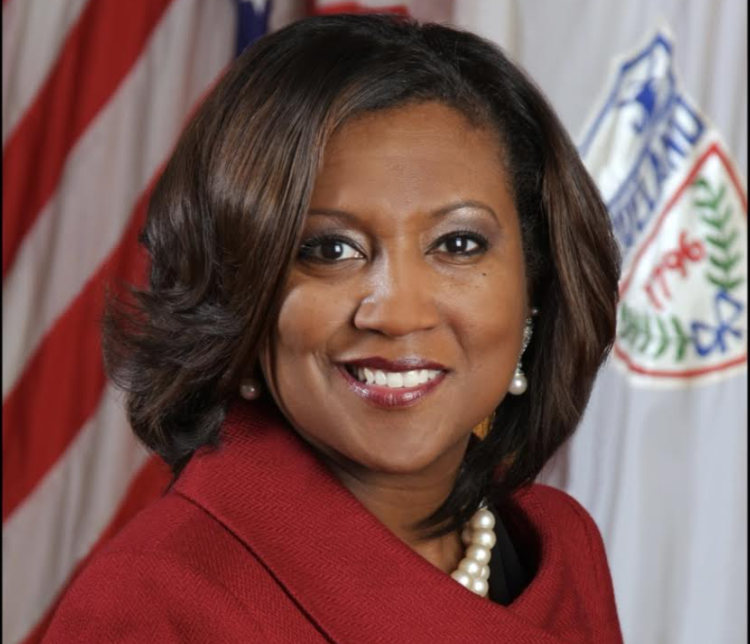Members of the Ohio Redistricting Commission are sworn in at the Ohio Statehouse. From left, Senate President Matt Huffman, state Auditor Keith Faber, House Minority Leader Emilia Sykes, Gov. Mike DeWine, Secretary of State Frank LaRose, House Speaker Bob Cupp and Sen. Vernon Sykes. Photo by Susan Tebben
In statements connected to lawsuits challenging Ohio’s recently approved legislative redistricting maps, GOP and Democratic mapmakers laid out the process of drawing legislative maps, including which legislative leaders and redistricting commission members met with them along the way.
Ray DiRossi, Blake Springhetti and Christopher Glassburn all gave hours-long depositions as part of three lawsuitschallenging the legislative redistricting maps approved by the Ohio Redistricting Commission in September.
DiRossi and Springhetti were both recruited to work for the Republican side as census data was received and negotiations began to create new state legislative district lines. DiRossi is the budget director for the Ohio Senate Republican Caucus, while Springhetti is the Director of Finance for the Ohio House of Representatives.
Glassburn, who has held previous positions within the Statehouse, was hired by the Ohio Senate Democratic Caucus via the government consulting business Project Govern, to be the predominant map-drawer for the Dems.
Starting the process

Up until August, DiRossi’s focus was on the state operating budget. But he said Senate President Matt Huffman and Ohio Senate chief of staff John Barron asked him to start the process of taking U.S. Census Bureau data and input into the software program Maptitude.
“My goal and what I viewed my role was — in those early days was putting forward a map for the president of the Senate to consider presenting to the redistricting commission that did not have any constitutional construction errors or problems in it and that found solutions to be a constitutional map,” DiRossi said.
He and Springhetti worked together in workstations side-by-side in DiRossi’s GOP Senate office, which shares a wall with Huffman’s office. DiRossi said he reported map changes to Huffman, and saw how the districts were being drawn, mainly “if I thought there was an issue or a problem, of which there were several.”
“After Aug. 12, I know the (Senate) president was extremely busy with other legislative duties, so I would — as I felt that I needed to interact with him, I would seek him out, either in person or in any other way, to give him updates on what I was seeing and working on,” DiRossi said.
Springhetti said he was asked to take on the role by House Speaker Bob Cupp in March or April of 2021. Preparation for drawing the maps started at the end of July, according to his deposition, something that involved starting from scratch for him, because he had no experience drawing legislative maps.
“You know, we were working around the clock to try to — to get something prepared,” Springhetti said. “I wouldn’t say that we had something — I wouldn’t say that on Sept. 1, I had something tangible to — to share.”
Glassburn said Senate Democrats brought him on in August specifically to work on redistricting maps, which he did from his home in Cleveland and at borrowed office space within the Senate Dems workspace.
Glassburn had “a few meetings with designated staff persons for all the Republican members of the commission,” but aside from meetings, no one worked with him and no one else drew maps with him.
As for Democratic leadership, Glassburn said he heard from state Sen. Vernon Sykes, co-chair of the ORC, and Senate Minority Leader Kenny Yuko later on in the process as negotiations reached a head.
The Democrat’s “predominant mapmaker” was the only one of the district drawers to use Dave’s Redistricting App instead of Maptitude, but he said his main goal, like the others, was to adhere to the rules laid out in the state constitution.
“I can tell you that my role as their consultant, I consistently advocated for us following the rules of the Constitution, including the timeline, and so it was the priority for us to submit a map in accordance with the timelines of the Constitution,” Glassburn said.
Springhetti said he was instructed to comply with “the mandatory sections” of the constitution as it related to redistricting.
In terms of initial goals the mapmaker said he had, he was instructed to try to put the city of Cincinnati in the minimum amount of House districts. As the process moved along, he said he reported his progress directly to the speaker, occasionally with other commission members or members’ staff there as well, including Huffman and DiRossi.
“In most cases (he and Cupp were) physically in the same room, and I would oftentimes show (Cupp) things directly on Maptitude,” Springhetti said.
Between Sept. 9 and the deadline of Sept. 15, Springhetti said he didn’t receive instructions regarding the drawing of maps from anyone other than Cupp.
Despite working in the same room, Springhetti said he and DiRossi’s conversations centered around map geography, and he denied ever receiving direction from Huffman.
Negotiations

As the map-making went on, and Senate Democrats had introduced a map early in September, DiRossi said he had several discussions with Huffman about Republican-leaning and Democrat-leaning districts, mainly those that would have been more Democrat-leaning in the Dems-proposed map.
“Yeah, the only thing I remember is that President Huffman said he had his own — his ideas, and he was — he was the one negotiating with the other members of the commission, and (to) keep drawing maps that were compliant with the other provisions of the constitution.”
DiRossi said the 6th Senate district was “a point of conversation,” and the 27th district, which could have had significantly reduced Republican leaning, was also something he made Huffman aware of, to which he said Huffman told him “if that’s what we have to do to follow the rules of the constitution, then we’re doing it.”
Springhetti said Cupp asked for the number of Republican-favoring seats and the number of Democrat-favoring seats, but the pursuit was one of compromise.
“He was negotiating with the members of the commission…he was trying to achieve a ten-year map,” Springhetti said. “And he wanted to address some of the — the concepts that the Democrats were bringing up in that pursuit, which was seats.”
Trumbull County came into play as a main focus for the speaker, with Springhetti saying Republicans wanted House and Senate district seats paired in the county, something that didn’t occur in the map previously proposed by the Senate Dems.
According to Glassburn, Republicans suggested a compromise of changing seats in Summit, Cuyahoga and Geauga counties “that made it no longer feasible to draw 15 Democratic Senate seats.”
“In that first meeting, (staffers for GOP commission members) were absolutely clear that if we did not resolve the Trumbull County issue that they were concerned with, that that was the nonstarter if that was not resolved to the way that they wanted it done, again, with the additional splits in Cuyahoga County and Geauga and all of that,” Glassburn said.
From DiRossi’s perspective, Cupp came in “late in the process” to ask about two House districts in Franklin County. He said Cupp asked about “trying to change the geography so that the two incumbents would switch districts.”
“I remember that being a significant request where it seemed to be that that was a significant focus of the — whoever he was negotiating with,” DiRossi told attorneys during the deposition.
DiRossi remembered during the final days of the legislative process, which he described as “very chaotic,” a specific meeting on Sept. 7 or 8 with Huffman and Secretary of State Frank LaRose, along with staffers from their offices. He said Cupp and Springhetti came in “very late” as well. In that meeting, he said LaRose encouraged Huffman and Cupp “to find a consensus ten-year map.”
Glassburn described an all-nighter he had in the days leading up to the Sept. 15 deadline, which he said was requested by Sykes and Yuko “to integrate as many changes as possible requested by Secretary LaRose and Auditor (Keith) Faber, and very late Speaker Cupp.”
“We were willing and did talk about every part of the state with the auditor and the secretary,” Glassburn said in his deposition.
The Democratic mapmaker said LaRose and Faber were a part of the map drawing process, with particular interest in Summit and Cuyahoga counties.
“We literally say down with Secretary LaRose and Auditor Faber and drew the maps with them on a television screen making changes as they asked,” Glassburn said.

DiRossi said he didn’t have specific conversations with Gov. Mike DeWine on mapmaking, but DeWine showed interest in “changing the geography in the 12th Senate district and the 1st Senate District along the lines of…what the district looked like when he represented it. I’m guessing.”
In a separate meeting between DiRossi, DeWine and Lt. Gov. Jon Husted, the governor and lieutenant governor heard about challenges in the maps that DiRossi said “would necessitate pairing a number of Republican members together.”
“And I remember (DeWine) saying, very similar to President Huffman, if that’s what we have to do to follow the constitution, then that’s what we have to do,” DiRossi said.
While Glassburn continued to have meetings with LaRose, Faber and their staffers, he said the governor’s office “dropped out of participation, now as a — you know, we’re not going to participate, they just — they just didn’t.”
“We offered meetings continuously to all of the commissioners, and it was always the two that I continue to describe, the auditor and the secretary, who participated,” Glassburn said.
The Senate GOP mapmaker didn’t have any direct interactions with the Democratic members of the redistricting commission, saying “that was for President Huffman to have.”
“You know, I understood that, whether it was Senator (and Minority Leader Kenny) Yuko or Senator Sykes — I never really got the impression that there were House Democrats involved in it,” DiRossi said. “But President Huffman was bringing back ideas from someone.”
One of the other challenges Republican mapmakers in particular had to deal with was notifying different lawmakers about changes to their districts in the map, even if those changes didn’t make it to the final version of the map.
Springhetti listed off different GOP legislators with whom he had to (at the direction of Cupp) discuss changes to their district “as their geography in the proposed map on (Sept. 9) would be significantly different.”
On the reaction of state reps. Tracy Richardson, Diane Grendell and Cindy Abrams, Springhetti said he received the same feedback: “She did not like the changes.”
Jon Cross was also notified of shifts in his district: “He did not like the changes,” according to Springhetti.
Grendell’s district was the only one changed in the final version, creating a more Democratic-leaning district.
DiRossi had the job of receiving feedback from GOP Senators who were told they may lose seats or reduced Republican lean, even before the maps were finalized.

“Senate (Niraj) Antani was very displeased and not happy about his district being made to be a Democrat-leaning district,” DiRossi said. “Senator (Kristina) Roegner was unhappy that her district (went) from being a very Republican-leaning district to a marginal Republican-leaning district. Senator (Mark) Romanchuk was very unhappy…and he made his — very politely, but made his displeasure known.”
DiRossi said he was also contacted by state Sen. Tom Patton “because he was not happy with the map, that he felt that was a negative thing for him.”
The lawsuits are still ongoing within the Ohio Supreme Court, which is scheduled to hear oral arguments in the cases in December. All the while, congressional redistricting is headed back to the state legislature for consideration after the redistricting commission failed to meet its Oct. 31 deadline. This came after the legislature had a first try for redistricting and never made it to their Oct. 1 deadline.
• • •• • •
This story is provided by Ohio Capital Journal, a part of States Newsroom, a national 501 (c)(3) nonprofit. See the original story here.




















